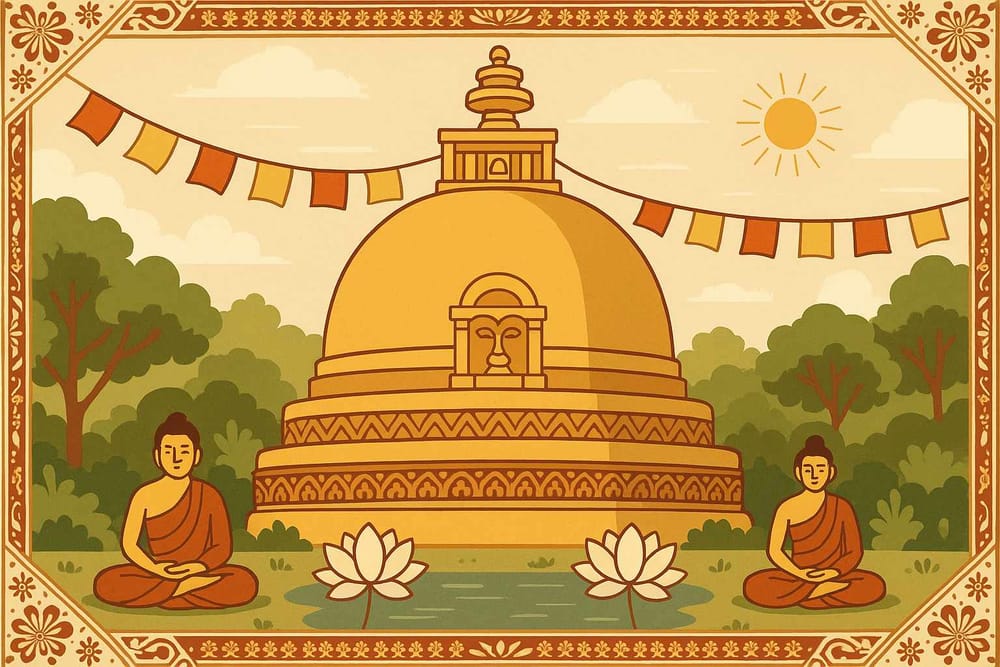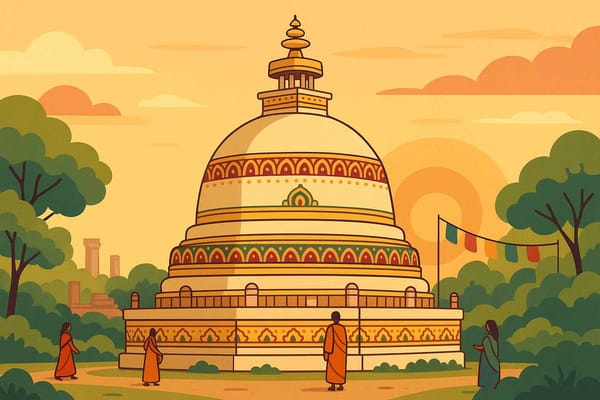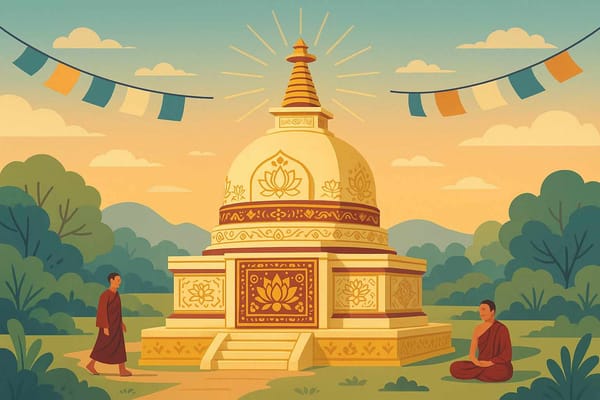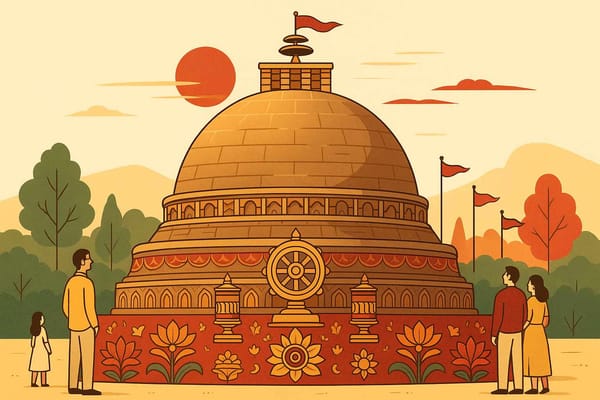
Exploring Dharmarajika Stupa: History-Spirituality Await
Have you ever stood in a place so ancient that you can almost feel the prayers of centuries echoing in the breeze? There are some places on earth that are not just destinations, but deep, spiritual experiences. The Dharmarajika Stupa in Taxila is one such sacred ground. It’s more than just a magnificent ruin; it's a testament to a king's profound faith and a symbol of peace that has weathered the storms of time for over two thousand years. Come, let’s walk this ancient path together and listen to the stories its silent stones have to tell.
A King's Devotion: The Birth of a Sacred Space
The story begins in the 3rd century BCE with the great Mauryan Emperor, Ashoka. After the heart-wrenching Kalinga war, his life took a transformative turn towards Dharma. To spread the Buddha's message of compassion, he commissioned the construction of numerous stupas, and Dharmarajika was one of the grandest. Its very name, "Dharmarajika," is believed to be inspired by the title 'Dharmaraja' – Lord of Law or Righteousness – a title used for both the Buddha and Emperor Ashoka himself. This was not just a monument; it was a king's promise etched in stone, built to house the sacred bone relics of the Buddha. Imagine the devotion that fueled its creation, making it a powerful pilgrimage site from its very first day.
Echoes of History: A Tale of Resilience and Rediscovery
Like any timeless story, the stupa’s journey was filled with trials. It stood strong for centuries, but history left its mark. A devastating earthquake shook its foundations between 25 and 30 AD, and in the 5th century, it faced destruction at the hands of the White Huns. Yet, the spirit of the place endured. It was restored and expanded over time, reaching its architectural peak in the 2nd century AD.
For centuries, its grandeur lay hidden, lost to the world, until the early 20th century when archaeologist Sir John Marshall began his excavations. It was like uncovering a forgotten chapter of our own heritage. His work revealed not just a structure, but a whole world of faith, art, and history, confirming its place as a priceless gem of our subcontinent's past. Today, it stands proudly as a UNESCO World Heritage Site, a reminder of what can be built and what must be preserved.
The Soul of the Stupa: A Fusion of Art and Spirituality
The design of the Dharmarajika Stupa is a beautiful lesson in Buddhist philosophy. The large hemispherical dome represents the vast, boundless universe. The path for circumambulation, or ‘pradakshina,’ invites devotees to walk in mindfulness, reflecting on the cyclical nature of life. It was a space designed for inner peace.
What makes it truly special is the beautiful blend of cultures. The intricate carvings show a strong Greco-Buddhist influence, a style that flourished in the Gandhara region. This artistic fusion tells a story of a world where ideas travelled freely along trade routes, and faith found expression in diverse artistic forms. One of its most remarkable features is a statue of the ‘Healing Buddha’, which connects ancient Buddhist practices to the holistic principles of Ayurveda. Near the stupa, a purification pool was also found, suggesting it was a centre for deep spiritual training and healing.
More Than a Monument: A Beacon of Learning and Culture
In its heyday, Taxila was not just a city; it was one of the ancient world's most renowned centres of learning. Scholars, monks, traders, and artists from across Asia gathered here. The Dharmarajika Stupa was the spiritual heart of this bustling intellectual hub. The surrounding monastic complex was alive with the chanting of monks and the philosophical debates of scholars. It was a place where faith and knowledge walked hand in hand. Much like how spiritual centres have always nurtured culture, as seen in Udaipur's living spiritual legacy, Taxila was a vibrant ecosystem of devotion and intellectual pursuit.
Exploring these stories and keeping them alive is a form of bhakti in itself. If you feel drawn to the rich tapestry of our spiritual heritage, you might find solace and inspiration in the pages of the Srimad Bhagavad Gita. Its timeless wisdom offers guidance that resonates deeply, even today.
Uncovering the Deeper Meaning of Dharmarajika
You might be wondering, what truly makes the Dharmarajika Stupa so special? It's the fact that it was built to enshrine the actual relics of Lord Buddha. This makes it an incredibly sacred site for Buddhists worldwide. Its spiritual power is palpable. For centuries, pilgrims have walked this land, seeking blessings and peace. Its significance lies not just in its age, but in the living faith it has inspired through generations.
And what about its location? The stupa is situated in Taxila, in modern-day Pakistan, an area that is an archaeological treasure trove. The entire region is dotted with monasteries, smaller stupas, and ruins that tell the story of a flourishing Buddhist civilization. Visiting the Dharmarajika Stupa means you are not just seeing one monument, but stepping into a vast, ancient spiritual landscape.
For anyone drawn to history, spirituality, or simply the beauty of ancient places, the Dharmarajika Stupa is open to visitors as part of the Taxila archaeological site. It offers a unique chance to connect with a profound heritage that has shaped our world in countless ways.
Why Its Story Matters to Us Today
In our fast-paced world, places like the Dharmarajika Stupa are like anchors. They remind us of the enduring power of faith, the importance of preserving our shared heritage, and the universal human quest for peace and enlightenment. Its story is a beautiful reminder that despite our differences, we are all part of a larger human journey. Whether you ever get to visit in person or simply explore its story from afar, the stupa invites you to pause, reflect, and connect with a wisdom that is truly timeless.
About Bhaktilipi
At Bhaktilipi, we believe that stories of faith and devotion are timeless treasures. We are dedicated to preserving and sharing the essence of our spiritual heritage in a way that resonates with modern seekers. Whether you wish to learn about sacred places like Dharmarajika Stupa or dive deep into scriptures, we offer authentic, thoughtfully crafted content to enrich your spiritual journey.
Explore our articles and resources that inspire and educate. Stay connected with a community that values devotion and history by following us on Facebook, Instagram, and YouTube. Let's grow spiritually, together.
© 2025 Bhaktilipi – Crafted with devotion.
A passionate group of people dedicated to preserving India's knowledge of Dharma, Karma, and Bhakti for ourselves and the world 🙏.
Comments
Related in

Exploring the Ancient Dharmarajika Stupa- History Unfolds
Imagine a place where the very air seems to hold the echoes of ancient chants, a place where stones, weathered by centuries, tell a story of unwavering faith. This isn't just a fantasy; it's the living legacy of the Dharmarajika Stupa in Taxila, Pakistan. This isn&

Dharmarajika Stupa- History Reveals Significance
Some places in the world don't just exist in the present; they carry the whispers of centuries within their very stones. Imagine standing on ground that witnessed a great emperor's change of heart, a place where the message of peace was shaped into a magnificent structure.

Dharmarajika Stupa: Journey Through History
Have you ever stood in a place so ancient that you can almost hear the whispers of history in the wind? A place where the stones themselves seem to tell stories of emperors, monks, and seekers from centuries ago. One such place is the magnificent Dharmarajika Stupa, nestled near Taxila
